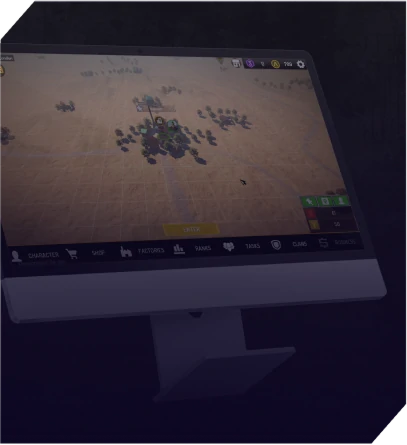About us
Blockchain technology aids in immersing a customer in a genuine gaming experience. It might be used as a token for in-app purchases or as the foundation for the entire game. Whimsy Games is the leading blockchain game development firm. Our team members are knowledgeable and experienced, and they are eager to create an exceptional product for your company. Why bother? Let's get in touch and collaborate on a new game!
Blockchain Game Development Services We Offer

Blockchain Game Development
With our crypto game development services you can create the many genres of blockchain based games — fantasy, sports, and so on — we employ cutting-edge techniques.

Gaming Platform Development
Our crypto game developers can help you build up your own marketplace where players can exchange in-game materials and characters.

Customizable Game Development
Users can create their own in-game environments. Customizable blockchain game creation helps individuals express their ideas and play a game for a longer period of time.

Blockchain Game Concept Creation
Instead of starting from scratch, you may choose one of our customizable game concepts. It might serve as a trial ground for your own game later on.

Blockchain Game Development for iOS and Android
We've got you covered, whether you need a game to operate nicely on iPhone or Android.
Why US
-
01
We have extensive experience in the blockchain game development industry.
-
02
Our team use tried-and-true technologies to build the game you've always wanted.
-
03
Our blockchain game developers will work with you to meet your goals, recommending the finest tools for the job.
-
04
We are constantly one step ahead of the most recent industry ideas.
-
05
We use this expertise to make our games appealing to players of all ages.
-
06
We will protect you from looming payments.
-
07
We will offer a precise calculation of the blockchain game development services at the start of a project.
How We Work
Features
-
 Confirming the Ownership of Game AssetsPassionate gamers may transform their pastime into a genuine income with the aid of blockchain. They may sell their in-game assets online since they own them while playing. Once the provenance of an object is established, it may be safely transferred to another user.
Confirming the Ownership of Game AssetsPassionate gamers may transform their pastime into a genuine income with the aid of blockchain. They may sell their in-game assets online since they own them while playing. Once the provenance of an object is established, it may be safely transferred to another user. -
 Getting Rid of FraudThe decentralized structure of the game blockchain helps secure the network against hacker assaults. As a result, developers may create new games on blockchain that do not require cheat codes.
Getting Rid of FraudThe decentralized structure of the game blockchain helps secure the network against hacker assaults. As a result, developers may create new games on blockchain that do not require cheat codes. -
 Giving Players Their PowerThe decentralized structure of the game blockchain helps secure the network against hacker assaults. As a result, developers may create new games on blockchain that do not require cheat codes.
Giving Players Their PowerThe decentralized structure of the game blockchain helps secure the network against hacker assaults. As a result, developers may create new games on blockchain that do not require cheat codes. -
 Decentralizing Gaming EconomyDevelopers may work on hybrid systems, allowing players to move their assets more easily. The gaming economy is built on blockchain, with other components hosted on centralized servers. As a result, game economies become more reliable throughout the process.
Decentralizing Gaming EconomyDevelopers may work on hybrid systems, allowing players to move their assets more easily. The gaming economy is built on blockchain, with other components hosted on centralized servers. As a result, game economies become more reliable throughout the process.
The Value of Whimsy Games




- Time Savers
- Easy Power-Ups
- Smart Spending
- Top Quality
Ready, Set, Go!
No waiting for respawns. We’re fast and always game to start!
Level Up Instantly!
Scale your project like a pro, from pixel beginnings to epic quests.
Win More, Spend Less!
Get legendary results without emptying your loot chest.
Play Flawlessly!
Every project gets our champion-level QA. No bugs allowed!
We strive for excellence













Genres We Сreate
- Arcade Games
- Action Games
- Fantasy Games
- Adventure Games
- PvP Battle Games
- Board Games

Arcade Games
We are professionals at generating fascinating puzzles and blending them into visually appealing designs.
Contact us
Action Games
In blockchain-based action games, our crypto game developers will ensure that gamers have an unforgettable experience.
Contact us
Fantasy Games
Whimsy Games, a blockchain game development company, has created hundreds of stunning gaming realms. The intriguing characters will captivate you for a long time.
Contact us
Adventure Games
Our adventure games on the blockchain have it all: endearing characters, wonderful surroundings, and impromptu gameplay. Along with the maps and outlooks, players may improve their abilities.
Contact us
PvP Battle Games
Allow people to convert their weapons and talents into stuff. We can assist you in creating an outstanding bespoke gameplay experience.
Contact us
Board Games
We can breathe new life into any old-school board game: picture Monopoly upgraded with blockchain technology.
Contact usProjects we’ve Brought to life
Game development services and art solutions
Frequently Asked Questions
What Is Your Process of Blockchain Game Development?
How Much Time is Needed to Create a Blockchain Game?
Why Outsource Blockchain Game Development?
- Expert Team: Get blockchain pros without starting from scratch.
- Saves Time: You focus on fun, we handle the tech.
- Cost-Effective: No need to hire a whole team – pay for what you need.
- Faster Launch: Outsourcing speeds up your game’s release.
- Quality Work: Get a polished, secure game.
- Latest Tech: Stay up-to-date with cutting-edge blockchain tools.
- More Creativity: Let us handle the tech, you make your game awesome.
Outsourcing isn’t just easy – it’s the smart choice to get your blockchain game done right!





























What our clients think about us